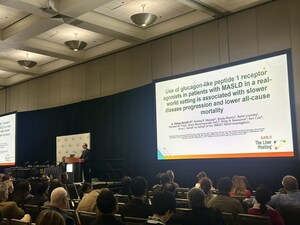DURHAM, N.C., June 11, 2024 /PRNewswire/ -- Target RWE presented new TARGET-NASH real-world data studies that analyzed glucagon-like peptide 1 (GLP-1) use and the NASH-CHECK patient-reported outcome (PRO) measures at the 2024 European Association for the Study of the Liver (EASL), June 5-8 in Milan, Italy.
The presentations included "Real-World Use of Glucagon-Like Peptide 1 (GLP-1) Receptor Agonists in Patients with MASLD: A Cross-Sectional Analysis from TARGET-NASH" and "A Prospective Analysis of Disease Progression Impact on Patient-Reported Outcomes in Metabolic Dysfunction-Associated Steatotic Liver Disease."
Real-World Use of Glucagon-Like Peptide 1 (GLP-1) Receptor Agonists in Patients with MASLD: A Cross-Sectional Analysis from TARGET-NASH
As GLP-1 receptor agonists are approved in the U.S. for diabetes and obesity, there is considerable interest in using this class of medications in patients with metabolic dysfunction associated with steatotic liver disease (MASLD); however, little observational data exists for this population.
In the new analysis leveraging data from the U.S. TARGET-NASH observational cohort, researchers described that 11% of the adult cohort, including patients with MASL, metabolic dysfunction-associated steatohepatitis (MASH), and MASLD with cirrhosis were prescribed GLP-1 therapy.
"GLP-1 treatments are at the forefront of metabolic liver research driven by the high prevalence of type 2 diabetes and obesity. Given that obesity and cardiovascular disease also continue to represent high rates of comorbidities in the MASLD population, it's imperative to patient characteristics among those who have been prescribed a GLP-1 in a real-world setting to better inform potential treatment pathways. Real-world evidence can be our roadmap to turning the tide on serious metabolic liver diseases." A. Sidney Barritt IV, MD, MSCR, Professor of Medicine, Director of Hepatology, and Transplant Hepatology Program Director in the Division of Gastroenterology and Hepatology, University of North Carolina School of Medicine, Chapel Hill. Dr. Barritt is the lead author for this publication and is a TARGET-NASH steering committee member.
This real-world MASLD population also had significant comorbid conditions: 99% had type 2 diabetes and 76% were obese (BMI >30kg/m2). Other co-morbidities included cardiovascular disease, hyperlipidemia, hypertension, autoimmune/rheumatological conditions, anxiety/depression, and arthritis.
A Prospective Analysis of Disease Progression Impact on Patient-Reported Outcomes in Metabolic Dysfunction-Associated Steatotic Liver Disease
Target RWE conducted a prospective analysis of the NASH-CHECK patient-reported outcome (PRO) measure in the real-world TARGET-NASH longitudinal cohort from 2021-2023 among a subset of adults enrolled in the U.S. The NASH-CHECK instrument is a MASLD-specific PRO measure that was previously developed and includes 6 symptom scale scores and 3 health-related quality of life scores (HRQOL). MASLD was defined per the TARGET-NASH pragmatic definitions using available biopsy, imaging, and clinical criteria.
In this cross-sectional analysis of NASH-CHECK in a real-world clinical setting, this recently validated MASLD-specific PRO demonstrated significantly worse scores in patients with MASH with cirrhosis compared to those with MASL or MASH in 6 out of 9 domains.
"Our analysis has yielded valuable insights into the impact of disease progression on patient-reported outcome measures in MASLD. The disparities observed in the HRQOL across different stages of MASLD, particularly the markedly worse scores in patients with cirrhosis, underscore the critical need for targeted interventions and personalized patient care. These findings highlight the importance of integrating PROs into clinical practice to understand the needs of this population better." Arun J. Sanyal, MBBS, MD, Director of Stravitz-Sanyal Institute for Liver Disease and Metabolic Health, Interim Chair of Division of Gastroenterology, Hepatology, and Nutrition, Z. Reno Vlahcevic Professor of Medicine, Physiology, and Molecular Pathology, Virginia Commonwealth University School of Medicine. Dr. Sanyal is also co-chair of the TARGET-NASH steering committee and co-author of both studies.
In addition to research at EASL 2024, a new publication in the American Journal of Gastroenterology found the new MASH nomenclature is highly concordant with the TARGET-NASH prior pragmatic definitions with 99% of patients enrolled in TARGET-NASH meeting the new MASLD diagnostic criteria. The publication is titled "High Concordance Between Nonalcoholic Fatty Liver Disease and Metabolic Dysfunction-Associated Steatotic Liver Disease in the TARGET-NASH Real-World Cohort."
Follow us on X (@TargetRWE) and LinkedIn to keep up with the latest news!
About Target RWE
As the industry's best-in-class, complete real-world evidence (RWE) solution, Target RWE is a distinctly collaborative enterprise that unifies real-world data (RWD) sets and advanced RWE analytics in an integrated community, shifting the paradigm in healthcare for how decisions are made to improve lives.
Target RWE sources unique, connected data sets across multiple therapeutic areas representing granular data from diverse patients in academic and community settings. Our rigorous, interactive, and advanced RWE analytics extract deep insights from RWD to answer important questions in healthcare. Target RWE brings together the brightest minds in healthcare through an unmatched community of key opinion leaders, patients, and healthcare stakeholders in a collaborative and dynamic model. www.targetrwe.com
Contact:
Kayla Slake
Senior Marketing Manager
[email protected]
984.234.0268 ext 205
SOURCE Target RWE

WANT YOUR COMPANY'S NEWS FEATURED ON PRNEWSWIRE.COM?
Newsrooms &
Influencers
Digital Media
Outlets
Journalists
Opted In






Share this article